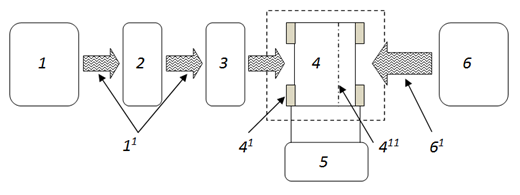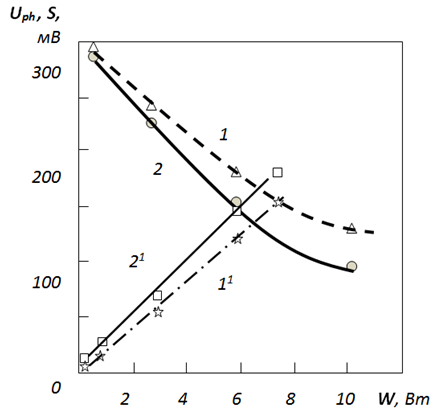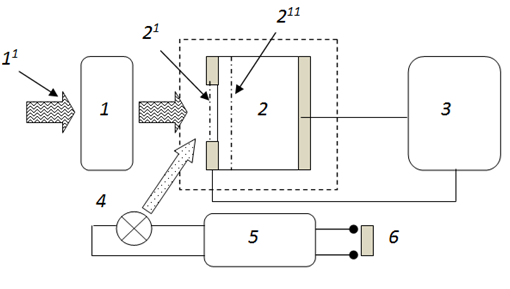eISSN: 2576-4543


Short Communication Volume 2 Issue 4
Andijan State University, Uzbekistan
Correspondence: Rayimjon Aliev, Senior Teacher of Physics, Andijan State University, Uzbekistan, Tel 9987-4223-8371, Fax 9987-4223-8830
Received: May 08, 2018 | Published: July 5, 2018
Citation: Aliev R, Muydinova M, Kahharov J. Modern problems and working out of the new method of measurement of characteristics of laser radiation. Phys Astron Int J. 2018;2(4):269-271. DOI: 10.15406/paij.2018.02.00097
In this work the new way of measurement of capacity of IR–radiation by means of silicon photo–electric structures is offered and developed. Results of test are resulted and the new way is scientifically proved.
Keywords: IR–radiation, energy distribution in a bunch, silicon photoelectric cell, the modulator, the germanium filter, a digital measuring instrument
The question of measurement of power parameters and characteristics of laser radiation is one of important problems of wide use of laser technologies in various branches of economy. For measurement of parameters of laser radiation the various methods based on various physical and chemical effects of interaction of laser radiation with substance can be used. The widely spread of it was received by such methods based on transformation of energy of laser radiation in thermal energy and direct in an electric current. The ponderomotive method based on transformation of energy of laser radiation in mechanical energy is also applied.1–3
Interaction of laser radiation with substance became one of the most actual problems of a modern science and technics. Radiation action essentially depends on parameters of radiation such, as: length of a wave, capacity and energy. Therefore, at research processes influence on substance careful measurement of such parameters, as capacity and energy of a beam, distribution of energy in cross section is important.
In the field of near infrared (IR)–radiations ( ) are applied various receivers. But for registration and measurement IR–radiations with length of a wave 10,6 microns (СО2–the laser) are applied only to some types of receivers. Photoelectric cells concern them on the basis of semiconductor alloy CdHgTe, Ge with a gold or copper impurity; semiconductor bolometer; pyroelectric sensors.
Photoelectrical cells are considered as the most sensitive sensors as they directly give out electric signals. However the Photoelectrical cells created on the basis of CdHgTe work at deep cooling (T=77oK) that causes corresponding complexities at operation. Semiconductor bolometers are usually characterized by low sensitivity and low speed, besides, they are applied to radiation with the limited limit of capacity. Pyroelectric receivers have high sensitivity and good speed, but they are calculated for registration of weak radiations on capacity.
In this connection, the problem was coming–to develop a new way of measurement of capacity of IR–radiation which would allow to expand functionality of the used device so that it was possible to measure not only capacity of radiation but also energy distribution on a cross profile. For the task in view decision it is offered to use silicon photoelectric cells as the detector of a thermal stream of IR–radiation. As a result of action of a thermal stream of IR–radiation on silicon temperature photoelectric cell changes depending on absorbed energy. If additional illumination of visible radiation (in the field of spectral sensitivity of silicon) to create initial an open circuit photo voltage under thermal action of IR–radiation value of a open circuit photo voltage changes. Uph according to the known equation:
(1)
Where a photocurrent, dark a saturation current. It is known that reduction of open circuit photo voltage is connected with increase in a return current of saturation at increase of its temperature.4 Experimental values of temperature factor of a open circuit photo voltage of Silicon photoelectric cell (dUph/dT) usually make 1,9÷2,5 mV/grad and change from an one to two elements a little, but are constant for each device in a wide range of light and temperatures diapasons. The most important thing–rectilinear change Uph of photoelectric cell from temperature remains in a wide temperature range.
The new device which block diagrammed on Figure 1 is developed for realization of the offered way. The device contains silicon photoelectric cell 4 with p+–p–n+–junction 411 and Omics contacts 41, a source of illumination 6, the registrar of photo–voltage 5. Photoelectric cell it is made by a method of ion implantation of phosphorus in epitaxial a polycrystalline film of silicon of p–type of conductivity with specific resistance , grown up of a gaseous phase on lower resistance ( ) a substrate of silicon of p+–type of conductivity.

Figure 1 The block scheme for measurement of capacity of a stream of IR–radiation: the IR–radiation 1–source, the 2–modulator, a 3–shutter, 4–silicon photoelectric cell, 41–ohmic contacts, 411–p–n–junction, a 5–digital measuring instrument, a 6–source of visible light, a 61–bunch of visible radiation.
Generated by the types of sources 1–LG (ЛГ)–25 or ILGN–109 IR–beam has been directed on photoelectric cell 4 through an attenuator of capacity 2 (type К945.04 from measuring instrument IMO–2Н and an automatic shutter 3 which allows expansion with a margin error ≈0,01s.
The results of control measurement are presented on Figure 2 where graphic dependences of a open circuit voltage led to. Dependence of Uph (1 and 2) and target signal S (11 and 21) from capacity of IR–radiation W for exposition time 𝜏, equal 5s (curves 1, 11) and 10 s (curves 2, 21).

Figure 2 Dependence Uph (1 and 2) and signal S (11 and 21) from capacity of a stream of IR–radiation: curves 1 and 11–for exposition time ; curves 2 and 21 for .
Apparently from the schedule, with growth of capacity of radiation W linearly decreases (curves 1 and 2), i.e. with change of capacity of radiation there is linear signal S (curves 11 and 21). According to dependence S (W=E/t) the received curves can serve as etalon curves for definition of capacity of a beams energy of E. Violation of linearity S transferred by it (W) at W > 7W (a curve 2) is connected with overheat of photoelectric cell. As experiments testify, it is possible to exclude similar infringement of linearity S(W) by decrease in time of an exposition (a curve 1). Hence, for expansion of a range of measurement on capacity of IR–radiation in the big party the further decrease in time of an exposition is necessary.
Thus, measurement of signal S, i.e. changes Uph photoelectric cell, on etalon a curve it is possible to define capacity or energy of IR–radiation. Thus that photoelectric cell possess high sensitivity to heating in comparison with semi–conductor bolometers as have diode structure with flat p–n–junction is important.
The physical nature of the offered way of measurement of IR–radiation is possible to present as follows. Photoelectric cell in the device is located so that illumination is directed on its obverse surface near to which p–n–junction is generated, and measured IR–radiation is directed on a surface opposite to it (Figure 1). Primary absorpti on of IR–radiation occurs near to a falling surface owing to what the superficial area heats up and there is a temperature gradient dT on a thickness of Silicon dx. The thermal stream dQ, directed deep into the semiconductor through cross–section section ds in time dt is defined by expression
(2)
where –factor of heat conductivity of a material. At achievement of thermal stream dQ borders of section of p–n–junction there is a change of an initial photo voltage, created by means of visible radiation (illumination). This change occurs until the temperature of area of p–n–junction will not reach the maximum value at which measured signal S will be fixed. Inertness of this device is defined by a time interval dt or, apparently from expression, thickness dx. In other words, as the thermal stream dQ is transferred in all thickness of photoelectric cell (dxSi) and it much more exceeds depth of p–n–junction (dxSi>>dxp–n), the offered device has high inertness that proved to be true at experimental measurements. Restoration of a reference value of a photo voltage Occurred in a current 1÷4s at the above–stated interval of capacity. For decrease inertness of photoelectric cell it is offered to arrange it so that IR–radiation and illumination have been directed to the same obverse surface. For increase of effective absorption of IR–radiation in superficial area, the film is put on surface of photoelectric cell oxide of Silicon SiOx by a method of vacuum thermal evaporation. This film simultaneously serves as an antireflection covering for visible radiation (illumination).
Performance of measurement and physical interpretation of results have allowed offer the new combined photoelectric device for measurement of capacity IR and visible radiations. The offered device (Figure 3) contains next components: the semiconductor filtering cell 1, executed in the form of a flat plate from single crystal of Ge which has factor transmission 90 % for λ=10,6µ, Silicon photoelectric cell 2, a radiator of a visible range 4 (a light–emitting diode or a bulb lamp), the measuring scheme 3, the power supply 5 with the switch 6.

Figure 3 The Block diagramme of the combined system for measurement of capacity of a stream visible and IR–radiations: the 1–filter, 2–Silicon photoelectric cell, a 3–digital measuring instrument, a 4–source of visible light, the 5–power supply, the 6–switch.
The combined device works in two modes as follows:
For measurement of capacity of visible radiation it is necessary to remove filtering cell 1 (Figure 3); as a result of a light stream falls on obverse surface photoelectric cell 2 where it will directly be transformed to an electric signal (photovoltaic effect); signal measurement (a photo votage) by means of the scheme 3 allows to define capacity of falling radiation;
For measurement of capacity of IR–radiation, in particular for λ=10,6µ, it is necessary to include (the switch 6) a radiator 4 which creates initial a photo voltage on photoelectric cell 2. Silicon photoelectric cell 2 contains the flat p–n–junction 211 located perpendicularly to a direction of falling of IR–radiation and also antireflection covering 21 of Silicon oxide in order to a good absorber for IR–radiation. Its turn provides high thermal sensitive of p–n–structures. The filtering cell 1 passes only IR–radiation under which thermal action there is change Uph i.e. there is signal S; the measurement S on etalon a curve defines capacity IR–radiations.
The offered way of measurement of capacity of radiation allows simplifying measurement process considerably. Measurement is spent at room temperature. As experiments show, in comparison with other methods it is possible to measure capacity of radiation in much wide range by using of Silicon photoelectric cell. Using of photoelectric cell with diode structure on a film basis, allows creating detectors with high sensitive and speed which can compete with pyroelectric detectors.
Possibility of manufacturing of the detector in a matrix form on the basis of the offered way of measurement is perspective. Matrixes from Silicon photoelectric cell allows to measure most precisely energy distribution on a beam profile. Creation of multiclass matrixes with photoelectric cells can be of great importance in working out of detectors of the thermal image with high resolution.
None.
Author declares there is no conflict of interest.

©2018 Aliev, et al. This is an open access article distributed under the terms of the, which permits unrestricted use, distribution, and build upon your work non-commercially.